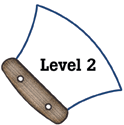
Alaska Science
Key Element A6
A student who meets the content standard should understand that forces of nature cause different types of motion, and describe the relationship between these forces and motion (Motion).
 |
Alaska Science A student who meets the content standard should understand that forces of nature cause different types of motion, and describe the relationship between these forces and motion (Motion). |
|
Performance Standard Level 2, Ages 8–10
|
|
|
|
Sample Assessment Ideas
|
|
|
Expanded Sample Assessment Idea
|
|
Materials
Procedure Students will:
Reflection and Revision
|
Levels of Performance |
||
|
Stage 4 |
Student work is complete, well-organized, and shows detailed evidence of the transfer and extension of knowledge that relates forces to an object’s speed, motion, and change in direction. All measurements, calculations, and graphs are accurate and clearly labeled. Student’s experimental analysis includes a detailed discussion of factors that affect reliability (track surface, friction, maintaining straight-line motion, etc.) and student incorporates this information to suggest appropriate experimental design changes that will reduce variability. | ||
|
Stage 3
|
Student work is mostly complete, organized, and shows some evidence of the transfer or extension of knowledge that relates forces to an object’s speed, motion, or change in direction. Most measurements, calculations, and graphs are accurate and labeled, although they may contain minor errors or omissions. Student’s experimental analysis includes a discussion of at least two factors that affect reliability (track surface, friction, maintaining straight-line motion, etc.) and student uses some of this information to suggest an experimental design change to reduce variability. | ||
|
Stage 2
|
Student work may be incomplete or poorly organized and shows little evidence of knowledge relating to forces, speed, or motion of an object. Measurements, calculations, and graphs are included but are incomplete, missing labels, or incorrect. Student’s experimental analysis, if included, may contain misconceptions or errors of reasoning. | ||
|
Stage 1
|
Student work is mostly incomplete, incorrect, or contains evidence of major misconceptions relating to forces, speed, or motion of an object. | ||
Standards Cross-References
|
||
|
National Science Education Standards The motion of an object can be described by its position, direction of motion, and speed. That motion can be measured and represented on a graph. (Page 154) An object that is not being subjected to a force will continue to move at a constant speed and in a straight line. (Page 154) |
Benchmarks Changes in speed or direction of motion are caused by forces. The greater the force is, the greater the change in motion will be. The more massive an object is, the less effect a given force will have. (Page 89) How fast things move differs greatly. Some things are so slow that their journey takes a long time; others move too fast for people to even see them. (Page 89) |
|
Table of Contents | Return to Alaska Native Knowledge Network